

SoMobNet International Roundtable on “Social Mobile Networking for Informal Learning” Programme. The STELLAR (The European Network of Excellence in TEL) Theme Team on “Social Mobile Networking for Informal Learning” (SoMobNet, International Roundtable at the Institute of Education in London on 21st November 2011.
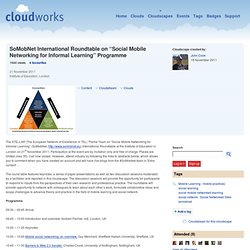
Participation at the event are by invitation only and free of charge. Places are limited (max 35). Call now closed. However, attend virtually by following the links to abstracts below, which allows you to comment when you have created an account and will have live blogs from the #SoMobNet team in 'Extra content' ...
The round table features keynotes, a series of paper presentations as well as two discussion sessions moderated by a facilitator and reported in this cloudscape. Social Learning — Cutting Edge Technology or Hype? You would be hard-pressed to read anything on higher educational technology these days without seeing a mention of social media in learning.

Social learning is the latest buzzword, and that was certainly evident at EduCause2011, which I attended two weeks ago. Yet social learning means a lot more than using social media as an add-on or afterthought; it is a learning paradigm with a lot to teach us. Soon after EduCause, I came across a 2009 white paper by the Frank Ganis with the Gilfus Education Group called, “Social Learning Buzz Masks Deeper Dimensions.” JISC to pioneer the use of social media technologies to improve the discovery of educational content. The UK is to participate in a global experiment, based on the social media technology behind Twitter and Facebook, to find out how the social activity around online educational content can be captured and fed back to users, creators and publishers.
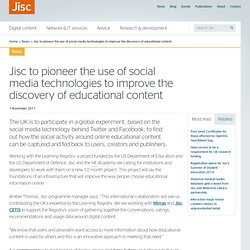
Working with the Learning Registry, a project funded by the US Department of Education and the US Department of Defence, Jisc and the HE Academy are calling for institutions and developers to work with them on a new 10 month project. This project will lay the foundations of an infrastructure that will improve the way people choose educational information online.
Amber Thomas, Jisc programme manager says, “This international collaboration will see us contributing the UK’s expertise to the Learning Registry. We are working with Mimas and Jisc CETIS to support the Registry’s vision of gathering together the conversations, ratings, recommendations and usage data around digital content. Mobile Tech Learning - 30+ Lesson Ideas for the iPad. Podcasting in the Classroom. The World Is My School: Welcome to the Era of Personalized Learning. By Maria H.
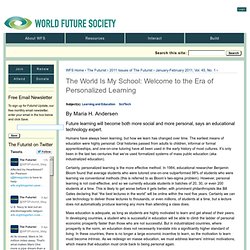
Andersen Future learning will become both more social and more personal, says an educational technology expert. Humans have always been learning, but how we learn has changed over time. The earliest means of education were highly personal: Oral histories passed from adults to children, informal or formal apprenticeships, and one-on-one tutoring have all been used in the early history of most cultures. It’s only been in the last two centuries that we’ve used formalized systems of mass public education (aka industrialized education). Certainly, personalized learning is the more effective method. Mass education is adequate, as long as students are highly motivated to learn and get ahead of their peers. 21st Century Educator. (Clay Shirky: How social media can make history) While education reformers like Michelle Rhee, Joel Klein, Bill Gates, and others will tell you that education is stuck in the status quo, right underneath their noses there is a quiet revolution occurring in education.
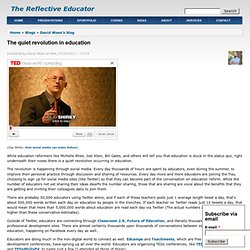
The revolution is happening through social media. Every day thousands of hours are spent by educators, even during the summer, to improve their personal practice through discussion and sharing of resources. Every day more and more educators are joining the fray, choosing to sign up for social media sites (like Twitter) so that they can become part of the conversation on education reform.
While the number of educators not yet sharing their ideas dwarfs the number sharing, those that are sharing are vocal about the benefits that they are getting and inviting their colleagues daily to join them. Educators are doing much in the non-digital world to connect as well. Social Media's Slow Slog Into the Ivory Towers of Academia - Josh Sternberg - Technology.
Underpinning a disdain for social media in higher education is the assumption that incoming students have an inherent aptitude for new technologies "If you took a soldier from a thousand years ago and put them on a battlefield, they'd be dead," Howard Rheingold, a professor teaching virtual community and social media at Stanford University, told me one morning via Skype.

"If you took a doctor from a thousand years ago and put them in a modern surgical theater, they would have no idea what to do. Take a professor from a thousand years ago and put them in a modern classroom, they would know where to stand and what to do. " Terms like "digital native" and "digital immigrant" have been used by marketers as a way of differentiating generations. This tale is not new. But as social interactions and technologies mature, there has been a swing in the pendulum. Teaching Social Media Theory "As faculty, we're always trying to engage our students better," Smith-Robbins says. Image: Creative Commons. Building Relationships in a High School Classroom. Growing networks of learning – part one – Learning to nurture ideas.
I’ve been thinking and studying networked learning since last December, when I stumbled into the world of educator personal learning networks, spread across the world. From my first blind stumbles across the edges of various twitter PLNs , to discussions and thinking with Kelly Tenkely about the Learning Genome , to witnessing connected learning courses with MOOCs like Stephen Downes and George Siemens’ CCK11 , to building my own PLN and contributing in collaborative efforts like the Reform Symposium . (Note: there are lots of links referencing deeper material in these posts. All of them will open an external window to avoid continually hitting the Back button in the browser. Apologies if you find this annoying.) Mobile Learning Handbook. This ADL Mobile Learning Handbook is a compilation of mobile learning resources.
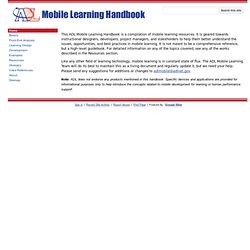
It is geared towards instructional designers, developers, project managers, and stakeholders to help them better understand the issues, opportunities, and best practices in mobile learning. It is not meant to be a comprehensive reference, but a high-level guidebook. For detailed information on any of the topics covered, see any of the works described in the Resources section. Like any other field of learning technology, mobile learning is in constant state of flux.
The ADL Mobile Learning Team will do its best to maintain this as a living document and regularly update it, but we need your help. Note: ADL does not endorse any products mentioned in this handbook.